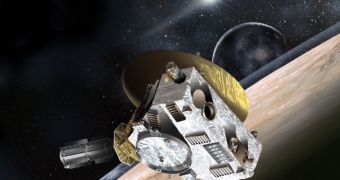NASA is proud to announce that its New Horizons spacecraft has finally passed the orbit of Uranus, on its long trek to Pluto, one of the farthest planets in the solar system. The probe is due to reach its destination sometime in 2015, mission plans indicate.
This major mission milestone was reached on Saturday, March 19, when New Horizons reached the gas giant's orbit at 6 pm EDT (2200 GMT). According to its odometer, the vehicle is currently some 1.8 billion miles (2.9 billion kilometers) away from our planet.
When it finally reaches Pluto, the probe will conduct in-depth surveys of the small planet, as well as of its three known moons, Charon, Nix and Hydra. Experts hope that this will allow them to clear up key mysteries related to the way the dwarf planet was formed, and how it behaves in its neighborhood.
It is also hoped that New Horizons will get a chance to see other objects in the distant Kuiper Belt before its July 2015 arrival at Pluto. The Belt is located beyond the orbit of Neptune, and contains a host of interesting bodies.
Some of these include the dwarf planets Eris, Haumea and Makemake, and the large planetoids Sedna, Orcus and Quaoar. It is widely believed that space rocks such as Neptune's moon Triton also originated in the Kuiper Belt in the distant history of the solar system.
“New Horizons is all about delayed gratification, and out 9 1/2-year cruise to the Pluto system illustrates that,” explains the principal investigator of the mission, Alan Stern.
“Crossing the orbit of Uranus is another milepost along our long journey to the very frontier of exploration,” adds the expert, who is based at the Southwest Research Institute in Boulder, Colorado.
When New Horizons left Earth in January 2006, NASA considered it to be its fastest spacecraft to date. Its outbound speed was more than 36,000 miles per hour, or 58,000 kilometers per hour, Space reports.
In the past 5 years, it traveled more than 20 astronomical units (AU), the mean distance separating the Earth from the Sun. In 2007, it carried out a Jupiter flyby, which corrected its orbit and boosted its speed even further.
“This mission is a marathon. The New Horizons team has been focused on keeping the spacecraft on course and preparing for Pluto,” says Glen Fountain, the spacecraft's project manager.
“So far, so good, and we are working to keep it that way,” adds the expert, who is based at the Johns Hopkins University (JHU) Applied Physics Laboratory (APL), in Laurel, Maryland.
The next major mission milestone is quite a distance away. It will occur on August 25, 2014, when New Horizons is scheduled to cross the orbit of Neptune. Interestingly, this will happen exactly 25 years after the Voyager 2 spacecraft – currently on the outer edges of the solar system – did the same.

 14 DAY TRIAL //
14 DAY TRIAL //